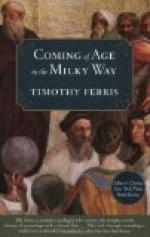
|
| Name: _________________________ | Period: ___________________ |
This test consists of 15 multiple choice questions and 5 short answer questions.
Multiple Choice Questions
1. The first step in the exploration of intergalactic space was taken by what philosopher?
(a) John Harrison.
(b) Emanuel Kant.
(c) Jean Richer.
(d) Claudius Ptolemy.
2. What is a device that uses electromagnetic fields to propel charged particles to high speeds and to contain them in well-defined beams?
(a) Particle accelerator.
(b) Spectrometer.
(c) Micrometer.
(d) Lepton.
3. Lambert wrote in his "Cosmological Letters" that the sun was a star on the a disc-shaped system of stars known as what?
(a) The Milky Way.
(b) The sun.
(c) Dark matter.
(d) Lepton.
4. William Herschel first became interested in nebulae when he read books by stargazers James Ferguson and whom?
(a) Robert Smith.
(b) Captain James Cook.
(c) Tycho Brahe.
(d) Rene Descartes.
5. Where was Albert Einstein born?
(a) France.
(b) Poland.
(c) England.
(d) Germany.
6. When did Protestant clergyman John Wilkins speak of man's settling on the moon?
(a) 1598.
(b) 1795.
(c) 1638.
(d) 1895.
7. What refers to the change in frequency of a wave for an observer moving relative to the source of the wave?
(a) Halley effect.
(b) Doppler effect.
(c) Richer effect.
(d) Geiser effect.
8. In what year did Charles Darwin theorize that the Dangerous Archipelago was once a series of volcanoes?
(a) 1735.
(b) 1834.
(c) 1802.
(d) 1902.
9. Although the behavior of gravitation still holds in Einstein's theory of relativity, there is a breakdown when it comes to gravitational fields within what?
(a) Quantum leaps.
(b) Triangulation.
(c) Black holes.
(d) Observational astronomy.
10. Who concluded that the process of the earth's creation was part of an infinite repeating cycle of development and destruction?
(a) George Gamow.
(b) Edwin Hubble.
(c) Aristotle.
(d) Fred Hoyle.
11. Who wrote in fourth century BC that "to consider the earth as the only populated world in infinite space is as absurd as to assert that in an entire field sown with millet only one grain will grow"?
(a) Emanuel Kant.
(b) John Harrison.
(c) Metrodorus.
(d) Aristotle.
12. Quantum physics first emerged in what year?
(a) 1818.
(b) 1905.
(c) 1796.
(d) 1900.
13. The photographs taken by who in England in the 1880s proved that most nebulae were spirals?
(a) James Keeler.
(b) Isaac Roberts.
(c) John Calvin.
(d) William Parsons.
14. Where was Charles Darwin from?
(a) Germany.
(b) England.
(c) Spain.
(d) France.
15. When was William Herschel born?
(a) 1819.
(b) 1738.
(c) 1845.
(d) 1920.
Short Answer Questions
1. According to the author, the universe could have emerged from nothing without violating any natural laws since the energy emitted from celestial objects (positive) is balanced by what, resulting in a net zero amount of energy?
2. Who discovered the period-luminosity phenomena that enabled the distances of the Milky Way and objects in deep space to be measured?
3. What is defined as a sacred narrative explaining how the world and humankind came to be in their present form?
4. The inflation hypothesis was first conceptualized by what American physicist?
5. In Chapter 15, the author writes that physicists learned that when an electron was elevated into a higher orbit, it moved from lower to higher orbit without what?
|
This section contains 474 words (approx. 2 pages at 300 words per page) |

|




